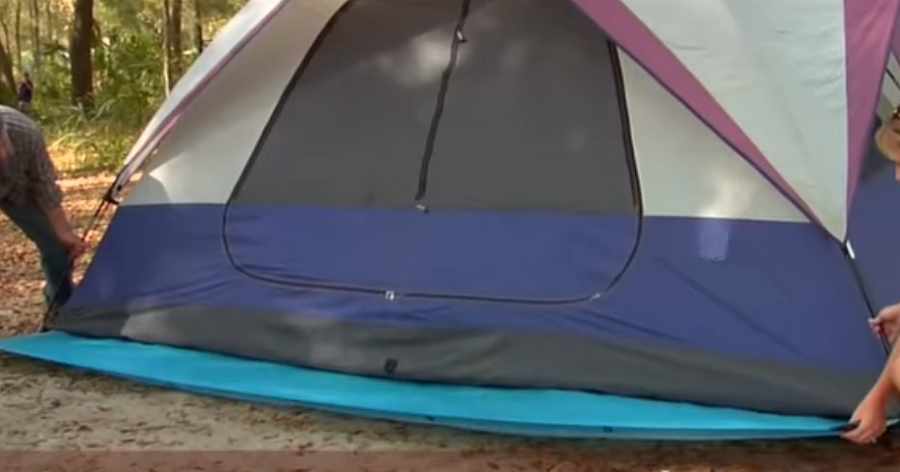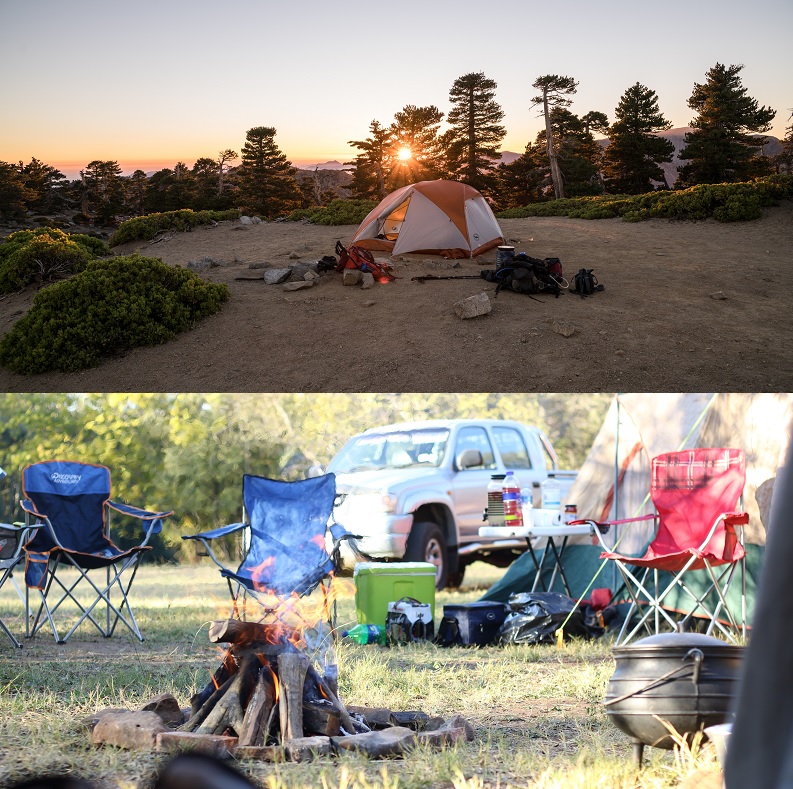When I first started camping I didn’t even know about using a tarp under my tent. When I did hear it I was still unconvinced that having one would be any benefit. But I was curious. So after trying a tarp under my tent I was surprised that it did have some benefits. Not anything major. I still go camping without one from time to time but I would say I am converted.
The benefits of using a tarp under your tent are mainly to protect it from rough ground. It will also save you from having to clean under your tent after camping. It also offers an extra layer of protection against the cold and damp. There are several different types of tarps that will suit your individual needs and I will discuss how to use them properly.
What does a ground cover do?
I touched on this above but the main benefit of having a tarp under your tent is to help it last longer. The floor of your tent is designed to stop moisture getting in. The material itself is not very robust so if you’re camping on rough ground it is easy to damage it.
Even though tent floors are waterproof after a few uses they may start to let moisture in due to damage from rough ground. A tarp not only helps this from happening but if it does then it offers an extra layer of waterproofness.
There are also benefits to using a tarp when camping on smooth ground. Even if it hasn’t been raining for a while there will still be moisture in the ground. This moisture is constantly evaporating. When you pitch a tent, it acts like a barrier and as a result the bottom of your tent will get soaked. Again this could lead to dampness in your tent even though it is completely dry weather.
When you are packing up you should make sure your tent is completely dry or mold will form when it’s stored away. With a ground sheet in place the bottom of your tent should remain completely dry.
Tarps also keep the floor of your tent clean. The last thing you want to do when you get back from a trip is to start cleaning mud off your tent. This will increase the life of your tent which could save you money. Tarps are very cheap in comparison to having to replace your entire tent.
What type of ground sheet do you need?
There are different types of sheet that you can use and all have their pros and cons. Hiking or car camping will have a effect of which type of ground cover you will want to use. The terrain will also have a major effect.
Tarp, short for tarpaulin, can be made from a variety of materials, can be waterproof or water resistant and have a variety of thickness. There are also a difference in grommet materials and the spacing of the grommets is also something to consider.
The grommet spacing will only be something worth considering when placing a tarp over your tent or somewhere that the wind can pull on the tarp but for the use of a ground cover this is not valid. Here are some of the most common types of trap.
Polyethylene (polytarp)
These are the most common type of tarp for camping. They are relatively inexpensive, lightweight and are waterproof. It is made from loosely woven strips of polyethylene. Make sure to get one that is UV treated, otherwise they will not last long if they are exposed to the sun. They will lose their waterproofness and will rip easily. Even UV treated poly tarps tend to lose their waterproofness over time, though this is more due to wear and tear.
Canvas
Canvas tarps are also quite popular for car campers but the extra weight means you won’t be using these on any hikes. They are a lot more robust than poly tarps, however they are only water resistance, not waterproof.
For this reason they are not ideal to be used as a ground sheets. The only time I would use a canvas is if I had to pitch on really rough ground. It does a way better job a smoothing out the bumps and protecting your tent.
Vinyl
This is even more abrasive resistant than canvas and it also waterproof. This is super heavy duty. It’s a bit overkill for camping so you won’t see much of it in the campground. That being said, if you are doing a lot of car camping and you want something that will last forever then this will be the stuff for you.
Other Types of ground sheet
I have seen people use some of the materials below as a ground sheet.
Tent footprint
Some tents give an option of buying a ready made ground sheet for your tent. This will come at the right size for your tent and will have pegs holes in the right place. This is a good option for most beginners as you may not know exactly what you need.
The only reason I would prefer a tarp over a footprint is that they can be more expensive and they are only good for one thing.
Tyvek
This is a building material used to wrap houses to make them waterproof, yet breathable. It is lightweight and durable, however it can be easily cut to whatever size you need. A good option if you are going hiking.
PVC sheet
If I’m going hiking without a tent I like to take a medium gauge clear PVC sheet. Around 4 x 6 ft. I lay my sleeping bag on it before I go to sleep to keep moisture down. I also use it as a makeshift, see through shelter if a shower comes along. I simply sit on the edge of it and against a tree and let it fall down in front of me. I can then sit and watch the rain without getting too wet. Keep the sides open for air and to stop it fogging up.
Tarp Thickness
You can get tarps in different thicknesses. Choose one that will suit your needs. Keep in mind that if you get heavier it will last longer but it will be more expensive and you will have more weight to carry. Basically, a thicker tarp is needed for rougher ground.
Below are the traditional U.S. color scheme for tarps. Keep in mind that not all manufacturers adhere to this color scheme.
- Blue – Light weight – 0.0055in (0.14mm) approx. thickness
- Yellow or Orange – Medium weight – 0.0075in (0.19mm) approx. thickness
- Green – Medium weight – 0.0095in (0.24mm) approx. thickness
- Silver – Heavy weight – 0.0115in (0.29mm) approx. thickness
- Brown – Super Heavy weight – 0.016in (0.41mm) approx. thickness
What size of Ground cover do you need?
Your ground sheet should cover the entire footprint of your tent and, more importantly, it should not stick out beyond the walls of the tent. If it does, them water will fall onto in and run under your tent. This is worse than having no ground sheet to start with because the water will be trapped there.
So the ground sheet should ideally be the the same size as the footprint of your tent. If it is a little bigger just tuck it in under your tent. When I’m using my two person tent I fold my tarp in half as it is much too big. I use the same tarp for my other bigger tent and I don’t want to cut it in half.
How to set your ground sheet
- Before laying the sheet have a look at the area to make sure there is nothing sharp that could cut your tarp.
- Spread out your tarp. You want it flat on the ground. Any bunching of the tarp will make the lumpy to lie on. If your tarp is the right size and has gromets then you could use pegs to hold it in place. However pegs are not essential for a ground sheet as the weight of the tent will keep it in place. If your tarp is much bigger then fold it over until it is roughly the same size as you tent.
- Pitch you tent as normal on top of the ground sheet.
- If you have part of the ground sheet sticking of out then roll it up towards the tent and tuck in under the tent floor.
- That’s it, you’re good to go.
Camping on a beach?
The process is a little different if you are camping on a beach. There is very little risk of damaging your tent on sand but dampness is still an issue.
- Firstly, pick a spot way above the tide line.
- Level out a spot in the sand and pitch your tent as normal.
- Once the tent is up, put your ground sheet inside your tent and cover the entire floor.
The reason for this is that during heavy rain water can pool under your tent which will allow the water to go between the ground sheet and tent, even if you have it tucked. Having the ground sheet inside will ensure you stay dry.
Packing your ground sheet away after camp.
- Inspect your tarp for damage after each use. You can get tarp repair tape to repair any holes or rips but I just use duct tape. Just make sure the damaged area is clean and dry before applying the tape.
- Make sure your tarp is completely clean and dry before folding. If this can’t be done on site then remember to do it when you get home.
- The best way to fold a tarp is to use two people and fan fold it. Basically over-lapping back and forth every 2 – 3 ft.
- If you store it away for the off season then use some sort of rodent repellent. The last thimg you want is for mice to make your tarp their home. It will be full of holes.
But do you really need one?
Well, no, it is not essential for camping. That being said, if you’re after spending a lot of money on a tent and you want it to last then, yes, for that reason it is essential. They can also add an extra layer of comfort and improve your tents moisture resistance. So I will leave it up to you to decide if you really need one or not.
That pretty much all you need to know about the use of tarps under your tent. If your have found this information helpful then please share by pressing one of the social buttons below so that others might learn from it too.



